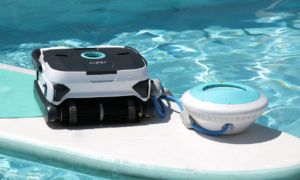Maintaining a pool in sparkling condition can seem like a never-ending war, requiring hours of skimming, brushing and vacuuming simply to stay ahead of leaves, algae and everything else. The old-fashioned manual cleaning routine wastes valuable weekend hours and can often provide inconsistent results. Enter: the robotic pool vacuum cleaner — a game-changing solution that turns cleaning your pool from a hands-on manual ordeal into a near hands-off task.
But with so many robotic pool cleaners on the market, the options can be daunting. Dozens of models feature different cleaning patterns, smart technologies and price points, making it necessary to narrow down your pool options with care. While this is all well and good, reliable customer support and on-demand maintenance services are of paramount importance beyond the purchasing point.
This comprehensive guide will walk you through the essential factors to consider when selecting a robotic pool cleaner. We’ll examine key features, compare leading models, and provide practical insights into after-sales support, helping you make an informed decision that ensures years of effortless pool maintenance.
Understanding Robotic Pool Vacuum Cleaners
Robotic pool vacuum cleaners are a major leap in pool maintenance technology, using self-contained units that combine powerful suction, advanced filtration, and intelligent navigation. At their heart, these tools are essentially a motorized pump, advanced filter system, and programmed control unit inside a waterproof shell with robust brushes and wheels.
Automated Pool Cleaners come in three basic categories: Suction-side models attach to your pool’s existing filtration system, providing basic cleaning abilities for a lower price point. Pressure-side cleaners operate using the water pressure from your pool’s return line for greater debris collection, but they need a second booster pump. Smart navigation models, including those from Dreame, provide the most thorough cleaning experience, featuring, among others, smart obstacle detection, custom cleaning patterns, and remote operation.
Automated cleaning robots perform much better than traditional manual cleaning methods at several crucial tasks. And they reduce water and energy use by using effective filtration, eliminate the need for extra pumping equipment, and provide consistent, thorough cleaning, regardless of pool configuration. More importantly, they liberate pool owners from the back-breaking task of doing manual cleaning and offer much better results because nothing gets missed on regular, systematic runs covering the walls, floor and waterline.
Comparing Pool Cleaning Robot Models: Key Features to Evaluate
Essential Performance Factors
Navigation technology is one of the key differentiators when evaluating robotic pool cleaners. High-end models use gyroscopic sensors to follow systematic scanning patterns for complete coverage of the pool, while entry-level units use pre-programmed random movements. The best cleaners leverage wall-climbing power with smart navigation to scrub pools clean from waterline to floor. At the other end of the spectrum, filter systems range from basic mesh bags to multi-layer cartridges, with higher-end models filtering out fine particles down to 2 microns.
Top Models in 2024
The market today includes multiple tiers of robotic cleaners, designed for different pool conditions. Basic models are great for small pools and basic debris collection but step-up models have smart functionality, including programmable schedules and remote control. Higher-end cleaners feature AI-powered navigation, advanced obstacle avoidance, and specialized brushes for multiple surface material types. Some manufacturers even provide pool-specific models that address specific pool challenges, such as improved leaf collection in pools located near trees or heavy-duty scrubbing in pools that see frequent algae growth.
Analyzing Customer Reviews
When researching customer experiences, look to long-term reliability reports vs. short-term impressions. Real reviews tend to cover details such as cleaning performance over several seasons and maintenance needs. Especially note comments about customer service interactions and parts availability. Many of the positive descriptors we hear about in products across price points center on energy efficiency and thorough cleaning, while recurring complaints are often about the cord tangling and how often the filters need to be maintained/replaced. Check reviews from several sources and look for consistent themes in performance and reliability.
Evaluating Customer Support and Aftersales Service
Well, the life and reliability of your robotic pool cleaner depends a lot on the quality of customer support and after-sales service from the manufacturer. Top brands usually have a more generous warranty, anywhere from 2 to 4 years, as well as clearly stated terms on parts replacement and repairs. Read warranty documentation closely before buying, so you know where limits are, especially with motor units and electronic components.
Having parts available is a huge part of maintaining your investment. Well-established manufacturers have long networks of authorized dealers and service centers that can get replacement parts like filters, brushes and drive belts into a customer’s hands quickly. Certain brands do this well by providing overnight shipping for critical components and keeping local inventory at their certified repair centers. Look into whether the manufacturer has a track record of continuing to provide parts for their older models, which indicates their commitment to supporting customers over the long haul.
From manufacturer to manufacturer, brand responsiveness to tech troubles varies widely. The most dependable companies offer multiple forms of technical support, such as around-the-clock phone support, step-by-step web-based troubleshooting guides and walkthrough video tutorials. Due to their rapid turnaround times, you should take into account how close you live to authorized service centers, so that when professional repairs are necessary, you can be out of a machine for no time at all. User forums and social media responses can reveal how well-overwhelmed brands are in addressing customer concerns and honoring warranty claims.
Step-by-Step Buying Guide for First-Time Purchasers
Start shopping for a robotic pool cleaner by correctly measuring your pool dimensions, including any deep-end steps or a beach entry. For rectangular pools, measure length and width at several points to adjust for moldy areas. Think about whether your pool has an angular shape or rounded sides; some models manage those features better than others.
When budgeting, factor in the price beyond the purchase price. Assess potential energy savings due to less pump runtime; add annual upkeep costs such as filters and brushes replacement. While the one at the high-end fetches a higher initial price, its better efficiency and durability typically lead to greater long-term value. Several manufacturers also have seasonal payment plans or financing options to lessen the impact of the investment.
Go to local pool supply dealers that perform product demonstrations before making a final purchase. Most retailers have display models or even short-term rentals and will let you evaluate performance firsthand. Use these opportunities to evaluate noise levels, check cleaning patterns and test user interface functionality. Create a comparison spreadsheet so you can get the essential features, warranty terms, and total cost of ownership across the models you are considering. Finally, check for local service support availability and return policy details before making your purchase.
Maintaining Your Robotic Pool Cleaner
Regular upkeep is essential for maximizing the functionality and longevity of your robotic pool cleaner. After each cleaning cycle, pull out and thoroughly rinse the filter cartridges with a garden hose, taking care to remove any fine debris lodged in the pleats. To keep the brushes working wonderfully well, give them a deep clean once a month, rubbing the algae and biofilm that will accumulate over the weeks. Store your device in a cool, dry place out of direct sunlight, and coil the cable loosely, without any kinks.
Most operational problems have very simple solutions. If the cleaner feels sluggish, check for full filter baskets or clogged impellers. Unpredictable movement behavior usually is a sign of twisted cables or brushed out motors that have to be replaced. If your unit is no longer climbing walls, take a look at the tracks or wheels for evidence of wear and check water chemistry — improper pH levels can compromise surface grip.
Many of them can be solved with household maintenance, however, in certain scenarios, expert help is needed. Departmental service centers must be contacted if you observe unusual sounds of motors, electric issues or huge decreases in cleaning effectiveness regardless of standard maintenance. Use manufacturer-approved parts and qualified technicians when having the vehicle serviced to help maintain warranty coverage and function of the vehicle.
Choosing the Right Robotic Pool Cleaner
So pick the right robotic pool cleaner to save time and money in the long run. The main idea here is that by carefully comparing the type of features you need for your pool, you can make an informed decision while also ensuring a reasonable total cost of ownership. Keep in mind that the most expensive model isn’t always the best fit — look instead for a cleaner that fits the size, shape, and typical debris patterns of your pool.
The quality of customer support and after-sales service should be a significant part of your decision. The difference between years of trouble-free operation and repeated frustration can simply be a comprehensive warranty, easily-obtainable replacement parts and responsive technical support. Check local service availability before committing to a specific brand or model.
When you cross-check with the comparative strategies of this guide, from community testing and analysis up to warranty assessment, you are guaranteed to pick a robotic pool cleaner that can deliver welcoming value over the long haul. Note that to get the best return out of your investment, proper cleaning is the key – so implement a regular cleaning routine, and deal with minor issues as they arise to guarantee your pool remains in pristine condition for as little hassle as possible for years to come!































